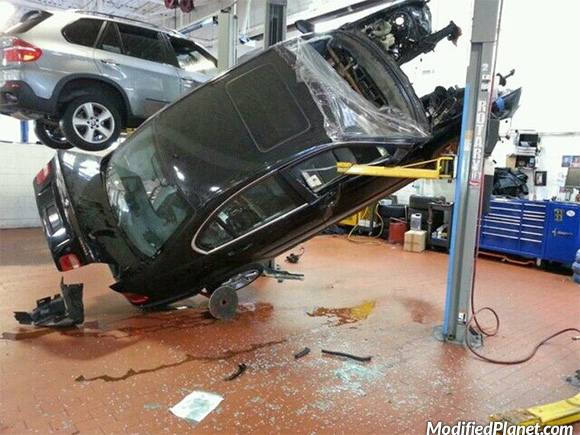You heard me.
You can figure out fore-aft CG from the static weight distribution: 50/50 means it'll be dead center between the wheels, 66.7/33.3 would be 1/3 of the way back from the front wheels to the rears, etc.
I don't know of a resource for vertical CG.
I can't imagine that shops do that for every vehicle that rolls in, but I'm also I'm sure that most just wing. That said, there must be some sort of industry guide.
I'm trying to figure out where to position a lift in my garage.
In reply to Woody:
That's a nice problem to have... I would think the equation would be driven by the longest vehicle with the worst weight distribution than you anticipate working on- a truck, maybe?
To really throw a wrench in this, what about the massive CG shift you get when you pull the drivetrain out of something? Or the engine out of the front of something with a rear transaxle?
NONACK wrote: To really throw a wrench in this, what about the massive CG shift you get when you pull the drivetrain out of something? Or the engine out of the front of something with a rear transaxle?
Yeah, um... be careful with that.

NONACK wrote: In reply to Woody: That's a nice problem to have... I would think the equation would be driven by the longest vehicle with the worst weight distribution than you anticipate working on- a truck, maybe?

Swing the arms wide and find the center of their reach? That should roughly correspond to where the lift manufacturer thought that center of the car should be and if you center that point in your space you should be close.
In reply to Woody:
Right. So figure out the CG to rear bumper distance on that beast, and put the center of the lift at least that far away from whatever it is you're concerned about clearing, plus a little room to move around?
In reply to Woody:
You're over thinking it. We always just took a guess, raised it up so the tires were just off the ground, pushed on the front and the rear, and decided if any adjustment needed to be made. Common sense prevails.
The shop that lets me graciously "rent" a 2-post lift occasionally has a paperback book that lists just about every vehicle ever and shows their lift points.
bravenrace wrote: In reply to Woody: You're over thinking it. We always just took a guess, raised it up so the tires were just off the ground, pushed on the front and the rear, and decided if any adjustment needed to be made. Common sense prevails.
this is always what we did down at school, get the tires about 3-6 inches off the ground and rock the car to see if adjustments need to be made, also one of these at the front and rear of the vehicle takes the worry out of it:

edizzle89 wrote:bravenrace wrote: In reply to Woody: You're over thinking it. We always just took a guess, raised it up so the tires were just off the ground, pushed on the front and the rear, and decided if any adjustment needed to be made. Common sense prevails.this is always what we did down at school, get the tires about 3-6 inches off the ground and rock the car to see if adjustments need to be made, also one of these at the front and rear of the vehicle takes the worry out of it:
great tools to have around and pretty cheap too
In reply to Woody:
You wouldn't have this issue at all if you bought a 4 post lift like I told you...![]()
If you ever find yourself asking, "Is there a resource that shows the X of all vehicles?" where X is not stock tire size, factory alignment spec, or lug torque spec, the answer is no.
GameboyRMH wrote: If you ever find yourself asking, "Is there a resource that shows the X of all vehicles?" where X is not stock tire size, factory alignment spec, or lug torque spec, the answer is no.
This is completely incorrect. As I said, there is a book that lists lift points. I do not, however, know who publishes it.
bravenrace wrote: In reply to Woody: You're over thinking it. We always just took a guess, raised it up so the tires were just off the ground, pushed on the front and the rear, and decided if any adjustment needed to be made. Common sense prevails.
From what I hear, entirely too few people did this properly where Elises were concerned.
I don't see the big deal. I mean, what's the worst that could happen? ![]()
Okay, don't lift any Toyota trucks and you should be good.

codrus wrote:bravenrace wrote: In reply to Woody: You're over thinking it. We always just took a guess, raised it up so the tires were just off the ground, pushed on the front and the rear, and decided if any adjustment needed to be made. Common sense prevails.From what I hear, entirely too few people did this properly where Elises were concerned.
Elises have very specific lift points on their chassis due to the way the chassis has been designed. Mine even came from the factor with "dot" stickers that show you where to put the arms.
1988RedT2 wrote: I don't see the big deal. I mean, what's the worst that could happen?Okay, don't lift any Toyota trucks and you should be good.

The absolute BEST part of that picture is the sizeable pile of frame rust on the ground below the failure point.
You'll need to log in to post.